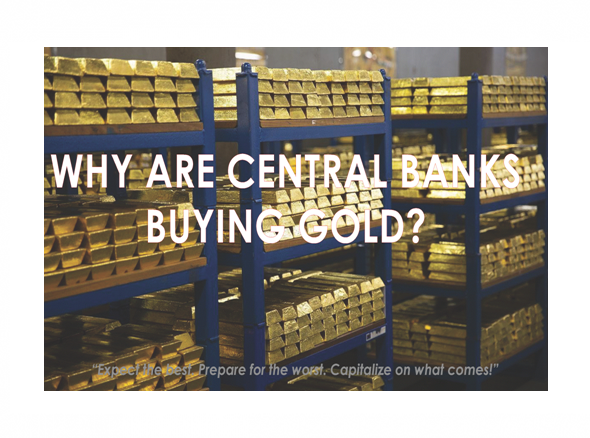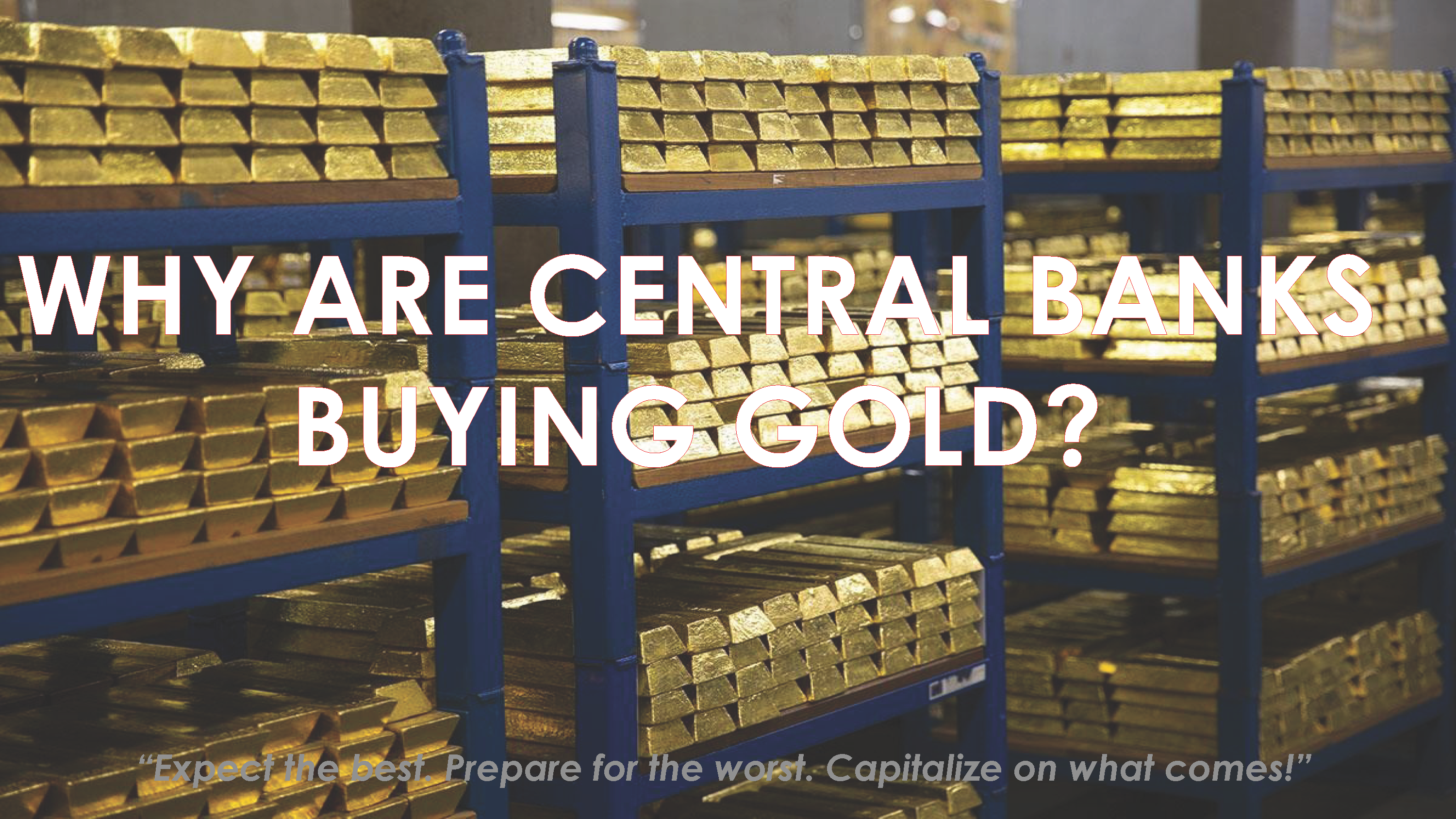IN-DEPTH: TRANSCRIPTION - LONGWave - 09-06-23 - SEPTEMBER - Why Are Central Banks Buying Gold
SLIDE DECK
TRANSCRIPTION
SLIDE 2
Thank you for joining me. I'm Gord Long.
A REMINDER BEFORE WE BEGIN: DO NO NOT TRADE FROM ANY OF THESE SLIDES - they are COMMENTARY for educational and discussion purposes ONLY.
Always consult a professional financial advisor before making any investment decisions.
SLIDE 3 - COVER
It’s no coincidence that the worst year ever for US Treasuries also saw the highest central bank gold buying spree in over 55 years. As Treasuries’ political and debasement risks rise, nobody should be surprised that demand for gold is skyrocketing. We should expect this trend to accelerate.
US Treasuries just experienced three consecutive years of losses. This is the worst in the history of the nation dating back 250 years to 1787.
Instead of parking savings in Treasuries increasing numbers of countries are parking their savings in gold. It is highly likely that soon institutional investors and the public will follow.
So far this year, central banks have bought about 25% of worldwide gold production. China is one of the biggest gold buyers. Meanwhile China has dumped over 25% of its massive stash of Treasuries since 2021.
At the same time, China has bought vast amounts of gold—five million ounces since last November, or nearly $10 billion.
SLIDE 4
Central banks and governments are the largest individual holders of gold in the world.
Together they own over 1.1 billion troy ounces of gold out of the 6.8 billion ounces humans have mined over thousands of years.
And those are just the official numbers that governments report. The actual gold holdings could be much higher because governments are often opaque about their gold, which they consider a crucial part of their economic security.
Russia and China—the US’ top geopolitical rivals—have been the biggest gold buyers over the last two decades. It’s no secret that China has been stashing away as much gold as possible for many years.
China is the world’s largest producer and buyer of gold. Russia is number two. Most of that gold finds its way into the Chinese and Russian government’s coffers.
As the trend of financial repression unfolds, we should expect central banks to accelerate their Treasury sales and gold purchases.
I would like to explore with why this happening and how you should be preparing for what is likely ahead.
As such I would like to cover the subjects listed here.
SLIDE 5
It is important to start with appreciating some of the key developments that have been occurring and accelerating since the beginning of the new millennium.
Since China entered the World Trade Organization in 2002 the world has steadily shifted from a Uni-Polar world centered on the US to a Multi-Polar world most recently shown with the steadily expanding anti-US$ BRICS-11 with their dominance in Energy and Commodities. I like to think of that combination as Physical Capital versus Financial Capital with Gold, Oil, Rare Earth Minerals and Food being real wealth versus paper claims.
Gold has cultural value in East whereas in the west it is viewed as a “Barbaric Relic”.
With China now using Swap lines to settle international trade accounts this has become a fundamentally different approach from the dollar reserve framework and means that trade can occur in renminbi without nations needing to hold vast reserves of other FX currencies.
Increasingly The London Bullion Market is losing its dominant gold monopoly pricing power to the Shanghai Gold Exchange
If the East (as represented by BRICS-11) is able to continue pushing up the price of gold it will weaken the West’s control over the price, allowing gold to break free of being a “Dollar Derivative”.
Gold also appears to becoming less sensitive to Real Rates as it historically has always tracked closely to the US 10Y TIPS.
SLIDE 6
Let’s now look at:
- WHO IS ACTUALLY BUYING GOLD?
- HOW MUCH ARE THEY BUYING? … AND
- HOW MUCH DO THEY HOLD?
SLIDE 7
The major official holdings of Gold by Central Banks are shown here. It is important to note that though the US shows the largest holdings it is highly questionable and the physical holdings have never actually been audited or disclosed publically. The concern is the Federal Reserve was a major leaser of gold during much of the late 80’s, the 1990’s and early 2000’s. That leased gold is believed to have gone into Jewelry so until Fort Knox is actually audited no one knows what the US actually has versus possibly a very creative set of accounting books.
Also it is pretty well acknowledged that China has far more Gold than it officially publishes. Now being one of the world’s largest Gold producers, as well as controller of the Shanghai Gold Exchange, it can hide its’ actually purchases. For years it was rumored that the major hidden buyer of Gold in Hong Kong was the Chinese Government.
SLIDE 8
The big shift in buyers since the 2008 Financial Crisis has been from Western Central Banks to the many countries who are members of the Shanghai Cooperation Organization which we will get into in a moment.
This shift is indicative of the world being on the verge of a paradigm shift in international finance as gold potentially replaces US Treasuries as the world’s premier store-of-value asset.
The last time the international monetary system experienced a paradigm shift of this magnitude was in 1971. Then, gold skyrocketed from $35 per ounce to $850 in 1980—a gain of over 2,300% or more than 24x. We could see a percentage rise in the price of gold to be at least as significant as it was during the last paradigm shift.
SLIDE 9
That’s because this coming gold bull market could be fundamentally different than other cyclical bull markets. It will be riding the wave of a powerful trend: the re-monetization of gold as the king store-of-value asset. It could potentially lead to the biggest gold bull market ever.
While this megatrend is already well underway, it is likely therefore that the most significant gains are still ahead.
SLIDE 10
- Gold demand soared to an 11-year high in 2022 on the back of “colossal central bank purchases, aided by vigorous retail investor buying,” -- World Gold Council
- Annual gold demand jumped 18% to 4,741 tons (excluding over-the-counter or OTC trading) across the year, the largest annual figure since 2011, fueled by record fourth-quarter demand of 1,337 tons.
- Key to the surge was a 55-year high of 1,136 tons bought by central banks across the year with the majority of these purchases being “unreported.”
- Despite significant selling by Turkey that slowed net central bank gold buying in the second quarter, central banks added a record amount of gold to their reserves through the first half of 2023.
- Net central bank gold purchases totaled 387 tons through the first half of the year, according to data compiled by the World Gold Council. That was the highest first-half total since the organization started compiling quarterly data in 2000.
- This marked a 152% increase from 2021, when central banks bought just 450 tons of gold. The World Gold Council attributed the spike to geopolitical uncertainty and high inflation.
SLIDE 11
- “This marked a banner year for central bank buying: 2022 was not only the thirteenth consecutive year of net purchases, but also the second highest level of annual demand on record back to 1950, boosted by +400t demand in both Q3 and Q4,” -- WGC.
- The group’s annual survey of policymakers revealed that the key drivers behind holding gold were its:
- “performance during times of crisis” and its
- “role as a long-term source of value.”
SLIDE 12
- “It’s hardly surprising then that in a year scarred by geopolitical uncertainty and rampant inflation, central banks opted to continue adding gold to their coffers and at an accelerated pace.”
- The majority of the central bank buying in 2022 came from “Emerging Markets” with
- The Central Bank of Turkey the largest buyer at a record 542 tons.
- BRICS-11 members of China, India, Egypt, Iraq and the UAE all significantly boosted their gold reserves over the year as well as oil countries such as Qatar and Oman
SLIDE 13
The most current reporting of the largest gold buyers between the Financial Crisis and the end of 2022 is shown here. Only a few of the countries shown on the list would be considered allies of the US.
It is also important to note the size of India’s holdings.
SLIDE 14
As an original BRICS member, India’s economic growth has allowed it to hold increasing quantities of gold. Shown on the right is India’s total gold import which is astoundingly over 16,000 tones!
This shows how the eastern culture values gold as real wealth as a lot of that also went into consumer jewelry.
SLIDE 15
The question is - why are these particular countries buying gold at such a rate while other countries have no interest in any further accumulation?
SLIDE 16
A good place to start is with the global foreign exchange reserves by currency.
Other than the area within the black wedge, global FX reserves are held primarily in G7 currencies.
The back wedge is China and other countries dominated by BRICS-11 countries and other rising global trading powers.
Unfortunately these powers suffer at the hands of G7 policies as a result of historical G7 currency, trade and military prowess.
SLIDE 17
The central banks buying gold are countries with a specific set of circumstances. As you have seen they are the BRICS-11 and the other Shanghai Cooperative Countries
SLIDE 18
As we mentioned earlier, the common drivers for the buying of gold are cultural values and perceptions of gold being real wealth.
Additionally there are now further major reasons such as:
- Crisis Preparation: Many, if not all see an Economic Crisis ahead and are preparing with the knowledge that Gold performs as an FX holding under difficult Financial Conditions,
- Domestic Gold Pricing: Gold Pricing in “Eastern” Currencies is Rising (their domestic currencies continue to weaken on the global stage controlled by the G7),
- US Foreign Policy: They want and need protection from the US Weaponization of US$ as evidenced by relentless US Sanction restrictions and the worrying unprecedented assault on a Russia Central Bank (Russia)over Ukraine,
- Bi-Lateral Trade Agreements: They are signing increasing Bi-Lateral trade within BRICS-11 & SCO where their currency is used without being forced through western banks and western regulatory controls.
- FX Reserves: As I mentioned earlier we they now have the Chinese using swap lines to settle international trade accounts. This is a fundamentally different approach from the dollar reserve framework and would mean that trade can occur in renminbi without nations needing to hold vast reserves of the currency
- PetroDollar: Many of the new purchasers of gold are tied to energy and the former PetroDollar Era which has now been jettisoned and operates in name only.
SLIDE 19
I just mentioned that many of these countries see a Crisis ahead and know Gold to be a solid way of protecting its wealth during such times. This is not just their opinion but a proven fact if history is to repeat itself.
Gold works brilliantly as a Recession Hedge.
SLIDE 20
Gold also shines when equities struggle. The column on the right has only one exception!
SLIDE 21
Even today Gold is tracking almost exactly against what occurred during and following the 2008 Financial Crisis
SLIDE 22
These countries see that Gold has returned on average 10%; and 7.8% annualized since 1970.
To central bankers looking primarily to protect their wealth, versus increase their wealth from the holding, to them this is as close to a sure bet as they can make!
SLIDE 23
Gold is up YTD in every currency and outperforming most domestic stock indices with the US being the notable acceptance (at least temporarily).
SLIDE 24
The leaders of the BRICS group of emerging economies – Brazil, Russia, India, China and South Africa convened a recent summit in Johannesburg in August where the BRICS was officially expanded to become BRICS-11
Across Southeast Asia, Africa and the Middle East, there are now concerted efforts to diminish the influence & Weaponization impact of the United States dollar. As the world’s largest trading nation, China has championed the internationalization of the Yuan for several years. The Russia-Ukraine conflict appears to have elevated the status of the Chinese currency…
However, the Yuan has many drawbacks.
- Lack of convertibility remains an obstacle for many global investors.
- The ability to control capital flows remains extremely important for Chinese authorities. Without it, large amounts of capital will flow out of China in search of safety.
- A fully internationalized Yuan is unlikely to happen unless Beijing allows greater currency freedom and both inward and outward investment, and fully establishes the rule of law.
SLIDE 25
Though Central Bank buying has been extremely robust in recent years it is susceptible to pressures somewhat out of their control that can influence their holdings. This has occurred in 2023 with Turkey’s gold holdings temporarily impacting the current year’s results.
We see that in the overall YTD Supply and Demand statistics put out by the World Gold Council.
SLIDE 26
As of the end of Q2 2022 we see supply on the left was 1255 tones which matches the demand on the right.
We see on the fifth line from the bottom on the right that central bank buying Y-o-Y for Q2 is down 35%. It is more than the second quarter being seasonally lower but also because increased FX holdings are currently under pressure as the global economy slows. There is pressure on country currency exchange changes that forces countries to take action to protect their currency as rate differentials can cause major disruptions, particularly when the major central banks like the US Federal Reserve so abruptly raise rates. It is very de-stabilizing.
SLIDE 27
We see here that selling by Turkey to protect its currency, shown by the black bar on the right has taken its toll on the recent numbers for the central banks.
SLIDE 28
Though other central banks may not be selling, their new purchases are down with a lack of FX reserve growth to buy gold with.
Clearly as the global economy slows further this will possibly impact gold pricing which may mean near-to-intermediate price pressures.
However, slowing economic growth normally means more fiscal stimulus spending, debt creation and rising inflation pressures where gold pricing shines. This is why gold is such a great recession and equity turmoil hedge.
SLIDE 29
There is a lot of talk in the press lately about the BRICS-11 moving towards Gold Backed Money as an alternative to the US dollar.
SLIDE 30
This is a big discussion which we don’t have time to delve into here. We are skeptical that is going to happen anytime soon or De-Dollarization becoming the problem near term as many see it to be.
MATASII.com was already talking about De-Dollarization coming in our 155 page, 2019 Thesis paper specifically entitled De-Dollarization – this was when no one was EVEN thinking about it.
What we have come to believe is we are actually moving towards something best labeled “Physical Capital” versus “Financial Capital” where lending and credit is increasingly more dependent on “Physical Collateral” versus third party risk involving paper collateral.
This is because Paper Collateral is highly subjected to the mysterious and unregulated world of Rehypothecation and the broad based derivative usage of Collateral Transformations and Collateral Swaps.
SLIDE 31
So what can we conclude?
SLIDE 32
We suspect we are on the verge of a paradigm shift in international finance as gold increasingly replaces US Treasuries as the world’s premier store-of-value asset.
The world is increasingly short of unencumbered and solid collateral. Collateral Contagion is a real possibility as we are seeing the earmarks of in Commercial Real Estate.
SLIDE 33
One given is that as debt increases in fiat currency based systems, gold values increase.
The only real questions you have to ask yourself are whether you see:
- Global debt increasing at faster rates?
- Current debt levels actually being extinguishable?
- Whether the US consumer will stop consuming more than it consumes
SLIDE 34
If you don’t, then Gold has only one way to go and that is up.
Also remember that the creator of the problem is governments and gold is their enemy.
Don’t be naïve enough not to fully believe Gold will come under heightened regulatory restrictions and predatory taxation as debt pressures mount.
Prepare accordingly!
SLIDE 35
As I always remind you in these videos, remember politicians and Central Banks will print the money to solve any and all problems, until such time as no one will take the money or it is of no value.
That day is still in the future so take advantage of the opportunities as they currently exist.
Investing is always easier when you know with relative certainty how the powers to be will react. Your chances of success go up dramatically.
The powers to be are now effectively trapped by policies of fiat currencies, unsound money, political polarization and global policy paralysis.
SLIDE 36
I would like take a moment as a reminder
DO NO NOT TRADE FROM ANY OF THESE SLIDES - they are for educational and discussions purposes ONLY.
As negative as these comments often are, there has seldom been a better time for investing. However, it requires careful analysis and not following what have traditionally been the true and tried approaches.
Do your reading and make sure you have a knowledgeable and well informed financial advisor.
So until we talk again, may 2023 turn out to be an outstanding investment year for you and your family?
I sincerely thank you for listening!






